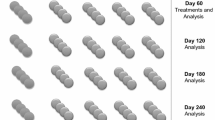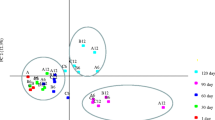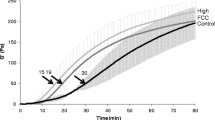Abstract
Changes on chemical and textural parameters were studied throughout maturation of PDO Ibores cheese. NCN/TN (non-casein nitrogen/total nitrogen) values were significantly modified (P < 0.001) throughout maturation, and significantly, lower values were observed at day 1 than at day 30, 60 and 90. Non-protein nitrogen/total nitrogen (NPN/TN) was not significantly changed during the ripening process (P > 0.05). Therefore, proteolysis extent (casein degradation and ‘ripening depth’) took place at initial stage and was limited throughout Ibores cheese maturation. In addition, since casein nitrogen decreased during the first month of ripening without a simultaneous increase in NPN/TN, this likely indicates that the large fragments of caseins liberated during this period are not further degraded into smaller products. Primary proteolysis (resulting from the action of endoproteases on caseins) is thus far more important than secondary proteolysis during this period. Moreover, secondary proteolysis remains limited along the 90 days. Polypeptide nitrogen significantly increased at day 30 from casein degradation compared to day 1, while free amino acids (FAA) content significantly increased during maturation process. In addition, hardness and adhesiveness values significantly increased, but cohesiveness and springiness significantly decreased up to day 60. Variables such as dry matter, NCN/TN and polypeptide nitrogen showed high correlations with textural parameters. Principal component analysis (PCA) of variables divided the Ibores cheeses according to their ripening: early, middle or late ripening.


Similar content being viewed by others
References
Antoniou KD, Petridis D, Raphaelides S, Ben Omar Z, Kesteloot R (2000) Texture assessment of French cheeses. J Food Sci 65:168–172
Ardö Y (1999) Evaluating proteolysis by analysing the N content of cheese fractions. Bulletin of IDF Nº 337:4–9
Atasoy AF, Türkoglu H (2009) Lipolysis in Urfa cheese produced from raw and pasteurized goats and cows milk with mesophilic or thermophilic cultures during ripening. Food Chem 115:71–78
Bourne MC (1978) Texture profile analysis. Food Technol 32:62–66
Bryant A, Ustunol Z, Steffe J (1995) Texture of Cheddar cheese as influenced by fat reduction. J Food Sci 60:1216–1219
Carballo J, Fresno JM, Tuero JR, Prieto JG, Bernardo A, Martín-Sarmiento R (1994) Characterization and biochemical changes during the ripening of a Spanish hard goat cheese. Food Chem 49:77–82
Creamer LK, Olson NF (1982) Rheological evaluation of maturing Cheddar cheese. J Food Sci 47:631–647
Delgado FJ, Rodríguez-Pinilla J, González-Crespo J, Ramírez R, Roa I (2010) Proteolysis and texture changes of a Spanish soft cheese (“Torta del Casar”) manufactured with raw ewe milk and vegetable rennet during ripening. Int J Food Sci Technol 45:512–519
DOE (2003) Diario Oficial de Extremadura (Regional Legislation of Extremadura), nº 61, 17th May 2003. Decreto 69/2003, de 20 de mayo, por el que se aprueba el Reglamento de la Denominación de Origen Protegida “Queso de Ibores” y su Consejo Regulador
FAOSTAT (2008) Food and agricultural commodities production: goat milk, whole, fresh. food and agriculture organization of the united nations statistical databases
Ferrandini E, López MP, Castillo M, Laencina J (2011) Influence of an artisanal rennet paste on proteolysis and textural properties of Murcia al Vino cheese. Food Chem 124:583–588
Folkertsma B, Fox PF (1992) Use of the Cd-ninhydrin reagent to assess proteolysis in cheese during ripening. J Dairy Res 59:217–224
Fox PF, McSweeney PLH (1996) Proteolysis in cheese during ripening. Food Rev Int 12:457–509
Franco I, Prieto B, Bernardo A, González J, Carballo J (2003) Biochemical changes throughout the ripening of a tradicional Spanish goat cheese variety (Babia-Laciana). Int Dairy J 13:221–230
Freitas AC, Fresno JM, Prieto B, Malcata FX, Carballo J (1997) Effects of ripening time and combination of ovine and caprine milks on proteolysis of picante cheese. Food Chem 60:219–229
Fresno JM, Tornadijo ME, Carballo J, González-Prieto J, Bernardo A (1996) Characterization and biochemical changes during the ripening of a Spanish craft goat’s milk cheese (Armada variety). Food Chem 55:225–230
Grappin R, Beuvier E (1997) Possible implications of milk pasteurization on the manufacture and sensory quality of ripened cheese. Int Dairy J 7:751–761
Halmos AL (2000) Relationships between instrumental texture measurements and sensory attributes. In: Nishinari K (ed) Hydrocolloids, Part 2. Elsevier, Amsterdam
IDF (1982) Cheese and processed cheese: moisture determination, determination of the total solids content (Standard 4A) international dairy federation, Brussels
IDF (1986) Fat, cheese and processed cheese: determination of fat content, Schmid–Bondzynskiratzlaff method (Standard 5B) international dairy federation, Brussels
IDF (1993) Protein determination, milk: determination of N content, Kjeldahl method, and calculation of crude protein content (Standard 20 B) international dairy federation, Brussels
Juan B, Ferragut V, Guamis B, Trujillo AJ (2008) The effect of high-pressure treatment at 300 MPa on ripening of ewes’ milk cheese. Int Dairy J 18:129–138
Martín-Hernández MC, Juárez M (1992) Biochemical characteristics of three types of goat cheese. J Dairy Sci 75:1747–1752
Medina M, Gaya P, Nuñez M (1992) Gredos goat’s milk cheese: microbiological and chemical changes throughout ripening. J Dairy Res 59:563–566
McSweeney PLH, Sousa MJ (2000) Biochemical pathways for the production of flavour compounds in cheeses during ripening. A review. Lait 80:293–324
Pinho EM, Alves MM, Ferreira IM (2004) Chemical, physical, and sensorial characteristics of “Terrincho” ewe cheese: changes during ripening and intravarietal comparison. J Dairy Sci 87:249–257
Psoni NT, Litopoulou-Tzanetaki E (2003) Microbiological characteristics of Batzos, a traditional Greek cheese from raw goat’s milk. Food Microbiol 20:575–582
Serhana M, Lindera M, Hosrib C, Fannia J (2010) Changes in proteolysis and volatile fraction during ripening of Darfiyeh, a Lebanese artisanal raw goat’s milk cheese. Small Rumin Res 90:75–82
Sousa MJ, Ardö Y, McSweeney PLH (2001) Advances in the study of proteolysis during cheese ripening. Int Dairy J 11:327–345
Tejada L, Abellán A, Cayuela JM, Martínez-Cacha A, Fernández-Salguero J (2008) Proteolysis in goats’ milk cheese made with calf rennet and plant coagulant. Int Dairy J 18:139–146
Upadhyay VK, McSweeney PLH, Magboul AAA, Fox PF (2004) Proteolysis in cheese during ripening. In: Fox PF, McSweeney PLH, Cogan TM, Guinee TP (eds) Cheese: chemistry, physics and microbiology, 3rd edn. Elsevier, Amsterdam
Van Hekken DL, Tunick MH, Park YW (2004) Rheological and proteolytic properties of Monterey Jack goat milk cheese during 6 months aging. J Agric Food Chem 52:5372–5377
Acknowledgments
This work has been financed thanks to European Regional Development Fund (ERDF). Francisco José Delgado thanks Junta de Extremadura for the grant received for the development of this work (DOE 10.10.07). R. Ramírez thanks INIA and ERDF for the contract conceded (BOE, 10.01.07).We thank the PDO dairies for providing the cheeses.
Author information
Authors and Affiliations
Corresponding author
Rights and permissions
About this article
Cite this article
Delgado, F.J., González-Crespo, J., Cava, R. et al. Proteolysis, texture and colour of a raw goat milk cheese throughout the maturation. Eur Food Res Technol 233, 483–488 (2011). https://doi.org/10.1007/s00217-011-1536-3
Received:
Revised:
Accepted:
Published:
Issue Date:
DOI: https://doi.org/10.1007/s00217-011-1536-3




